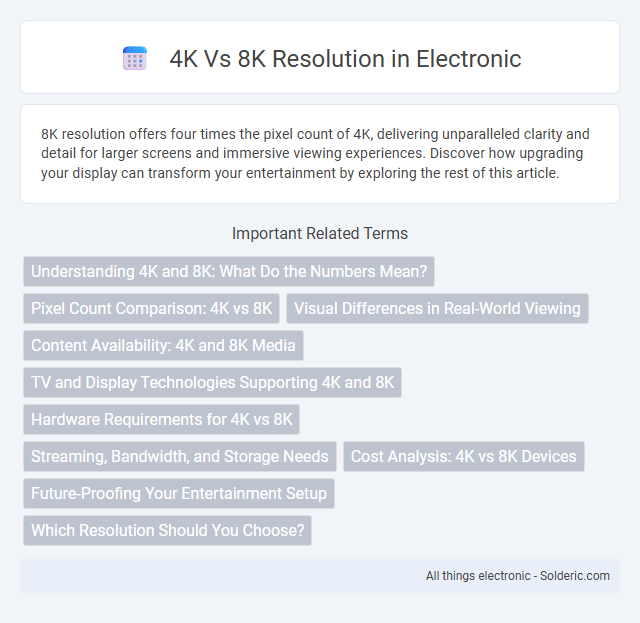8K resolution offers four times the pixel count of 4K, delivering unparalleled clarity and detail for larger screens and immersive viewing experiences. Discover how upgrading your display can transform your entertainment by exploring the rest of this article.
Comparison Table
| Feature | 4K Resolution | 8K Resolution |
|---|---|---|
| Pixel Count | 8.3 million pixels (3840 x 2160) | 33.2 million pixels (7680 x 4320) |
| Image Detail | Ultra HD, sharp detail | Superior detail, four times 4K |
| Screen Size Suitability | Ideal up to 65 inches | Best for 65 inches and larger |
| Bandwidth Requirements | 25 Mbps for streaming | 50+ Mbps for streaming |
| Content Availability | Extensive 4K content | Limited 8K content currently |
| Cost | More affordable | Higher price premium |
| Hardware Support | Widely supported by TVs and devices | Emerging support, newer models |
Understanding 4K and 8K: What Do the Numbers Mean?
4K resolution refers to a display resolution of approximately 3840 x 2160 pixels, offering four times the pixel count of Full HD (1080p), while 8K resolution doubles that again to around 7680 x 4320 pixels, providing sixteen times the pixels of Full HD. The increased pixel density in 8K delivers sharper images and finer detail, especially noticeable on larger screens or when sitting close to the display. Understanding these numbers helps you determine which resolution best suits your viewing distance, screen size, and content availability for optimal visual experience.
Pixel Count Comparison: 4K vs 8K
8K resolution offers a pixel count of approximately 33.2 million pixels, which is four times the 8.3 million pixels found in 4K displays. This significant increase in pixel density results in sharper images and enhanced detail, especially on larger screens or when viewed up close. The difference in pixel count makes 8K ideal for professional applications and future-proofing, though content availability and hardware support remain limited compared to 4K.
Visual Differences in Real-World Viewing
8K resolution offers four times the pixel count of 4K, resulting in significantly sharper and more detailed images, especially noticeable on larger screens above 65 inches. In real-world viewing conditions, the increased pixel density of 8K reduces visible pixelation and enhances texture clarity, making fine details like foliage or fabric patterns more lifelike. However, the perceptible difference depends on viewing distance; at typical living room distances, 8K's benefits are less discernible compared to 4K on standard screen sizes.
Content Availability: 4K and 8K Media
4K resolution currently offers a vast and diverse library of content across streaming services, Blu-ray discs, and gaming platforms, making it the more accessible choice for consumers. 8K media, however, remains limited with few native titles available, as content creators and broadcasters are still adapting to the higher resolution demands. Your best experience depends on the availability of compatible 8K content, but 4K dominates in terms of variety and affordability.
TV and Display Technologies Supporting 4K and 8K
Modern TVs and display technologies supporting 4K resolution typically feature OLED, QLED, and LED panels, delivering sharp images with a pixel count of 3840x2160. In contrast, 8K resolution TVs boast a much higher pixel count of 7680x4320, utilizing advanced micro-LED and next-generation OLED technologies to provide unparalleled detail and clarity. When choosing your display, consider the availability of content and hardware compatibility designed specifically for 4K or 8K resolutions to fully experience these high-definition formats.
Hardware Requirements for 4K vs 8K
4K resolution demands a moderate level of hardware power, including GPUs with at least 4GB VRAM and HDMI 2.0 ports to handle 3840x2160 pixels at 60Hz, while 8K resolution requires ultra-high-performance components such as GPUs with 10GB or more VRAM, HDMI 2.1 or DisplayPort 1.4 inputs, and advanced cooling systems to manage the massive 7680x4320 pixel output. The processing power and memory bandwidth needed for 8K content are significantly greater, often necessitating the latest generation of graphics cards like NVIDIA RTX 4080 or AMD RX 7900 XT to ensure smooth playback and gaming experience. Power consumption and heat generation are also considerably higher for 8K hardware, requiring robust power supplies and efficient thermal solutions.
Streaming, Bandwidth, and Storage Needs
8K resolution requires significantly higher bandwidth than 4K, often exceeding 80 Mbps compared to 15-25 Mbps for 4K streaming, posing challenges for current internet infrastructures. Streaming 8K content demands advanced compression technologies like AV1 or HEVC to manage data flow efficiently. Storage needs for 8K media are exponentially greater, with raw footage consuming up to four times the space of 4K, necessitating substantial upgrades in local and cloud storage solutions.
Cost Analysis: 4K vs 8K Devices
4K devices generally offer a more cost-effective option with prices significantly lower than 8K counterparts due to mature manufacturing processes and widespread adoption. 8K devices remain premium products, often priced two to three times higher, reflecting advanced technology, limited production, and higher resolution panels. Consumers must weigh the incremental visual benefits against the substantial price difference when considering 4K versus 8K displays.
Future-Proofing Your Entertainment Setup
8K resolution offers four times the pixel density of 4K, delivering incredibly sharp and detailed images that can future-proof your entertainment setup as content production advances. Investing in 8K TVs ensures compatibility with emerging high-resolution broadcasts and streaming services, maximizing your viewing experience for years to come. Enhanced color accuracy and higher dynamic range support in 8K displays also contribute to a richer, more immersive visual environment compared to 4K screens.
Which Resolution Should You Choose?
Choosing between 4K and 8K resolution depends on your display size, viewing distance, and content availability. 4K resolution offers excellent clarity for TVs up to 65 inches and is widely supported by streaming services and gaming consoles. 8K provides unmatched detail on screens larger than 75 inches but requires significant bandwidth and compatible devices, making 4K the more practical choice for most users today.
4K vs 8K resolution Infographic

 solderic.com
solderic.com